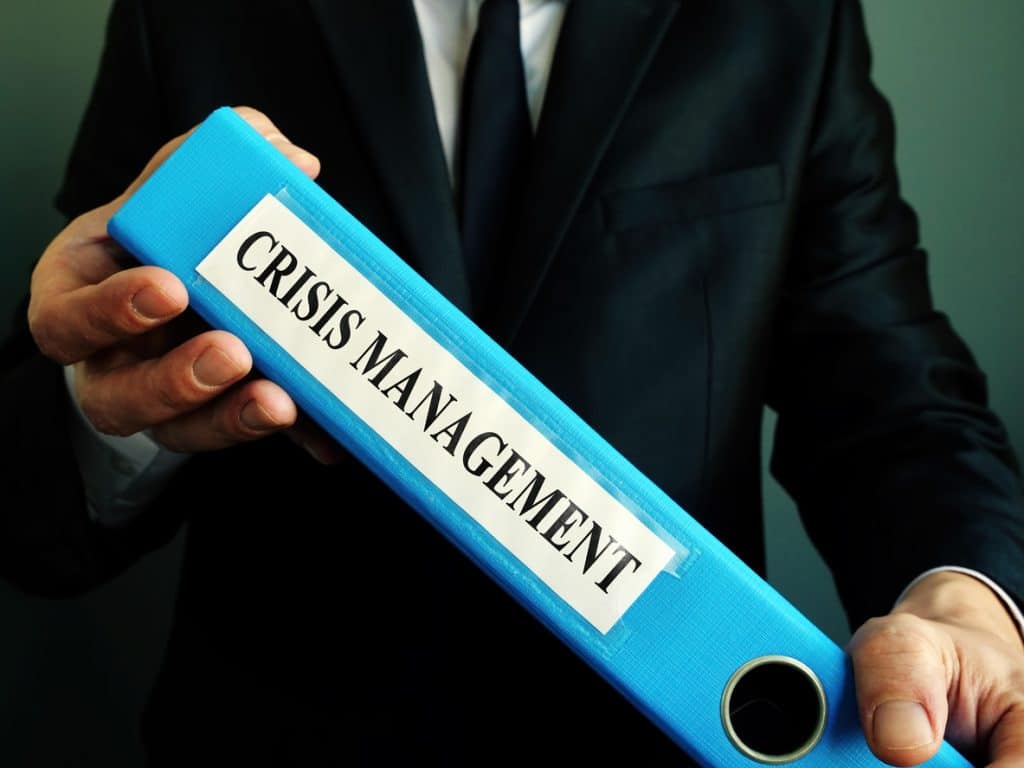The Ultimate Guide to Creating a Crisis Management Plan That Works

In this article
Are you prepared for a crisis? A crisis can strike at any moment, and without a solid plan in place, your business could be left vulnerable. In this guide, we’ll walk you through the steps to create a crisis management plan that will help you mitigate risk and keep your business running smoothly.
But first let’s define a crisis management plan. A crisis management plan is a document that outlines how your organisation should respond to a particular crisis or emerging issue. It provides direction on how to respond quickly and effectively, as well as strategies for managing the situation in an organised and proactive manner. The plan should also consider contingencies in the event of unexpected developments or disasters.
What is crisis management planning?
Crisis management planning is the process of developing a strategy and set of procedures to handle unexpected events that can negatively impact a business or organisation. It involves identifying potential crises, creating a plan to respond to them, and training personnel to carry out that plan effectively.
Why is crisis management planning important?
Crisis management planning is important because it helps organisations prepare for unexpected events, reducing the risk of long-term damage to the business or brand. By having a plan in place, organisations can respond quickly and efficiently to a crisis, minimizing the impact and ensuring a faster recovery.
What are some common crises that organisations should prepare for?
There are several types of crises that organisations should prepare for, including natural disasters, cyber attacks, product recalls, public health emergencies, and workplace accidents. It’s important to identify the specific types of crises that are most relevant to your business or industry and develop a plan to address them.
Who should be involved in crisis management planning?
Crisis management planning should involve a team of key personnel from various departments within the organisation, including senior management, legal, IT, public relations, and operations. Each member of the team should have clearly defined roles and responsibilities, and the team should work together to develop and implement the crisis management plan.
How often should an organisation update its crisis management plan?
Organisations should review and update their crisis management plan on a regular basis, at least once a year or whenever there are significant changes to the business or industry. It’s important to ensure that the plan remains relevant and effective, and that all personnel are trained and prepared to carry out the plan in the event of a crisis.
No one wants to think about the worst-case scenario, but it’s important for businesses to have a crisis management plan in place. Whether it’s a natural disaster, a cyber attack, or a public relations nightmare, having a plan can help businesses minimize damage and quickly get back on track. In this article, we’ll outline the steps for creating a crisis management plan so that you can be prepared for whatever comes your way.
Looking for a Crisis Management Plan Template?
Simplify System’s crisis management plan has been developed to assist businesses and organisations with establishing a plan to outline the arrangements for the preparation, response and follow up of a crisis situation. Developed by qualified risk and safety management specialists.

Crisis Management Plan
Step 1: Identify Potential Risks
In order to create an effective crisis management plan, it is crucial to first identify potential risks that could affect your business. These risks can come in many forms, such as natural disasters, cyber attacks, product recalls, or even public relations crises. By identifying these risks ahead of time, you can be better prepared to address them and minimize their impact on your business.
Here are some tips for identifying potential risks:
Conduct a risk assessment:
This involves assessing your business operations and identifying areas that may be vulnerable to potential risks. Look at each aspect of your business and consider what could go wrong, as well as the likelihood and potential impact of each scenario.
Consider external factors:
Think about factors outside of your business that could pose a risk, such as natural disasters, political instability, or changes in the market.
Analyse past incidents:
Review any previous incidents that may have affected your business and use them to identify potential risks in the future.
Once you have identified potential risks, you can move on to the next step of creating a crisis management plan: assessing the potential impact of each risk and developing strategies to mitigate them. By taking the time to identify potential risks, you can be better prepared to handle any crises that may arise in the future.
Step 2: Develop a Communication Plan
During a crisis, effective communication is essential to managing the situation and minimizing the impact on your business. Developing a comprehensive communication plan will help you ensure that information is disseminated quickly and accurately to all stakeholders. Here are some key steps to consider when developing your communication plan:
- Identify a designated spokesperson: Your communication plan should identify a specific person or team who will be responsible for communicating with stakeholders during a crisis. This person should be trained in crisis communication and have the authority to make decisions on behalf of the organisation.
- Create a list of stakeholders: Your communication plan should include a list of all stakeholders who need to be notified during a crisis. This may include employees, customers, suppliers, investors, regulators, and the media. Make sure to keep this list up-to-date and have multiple ways to contact each stakeholder.
- Develop key messages: Before a crisis occurs, develop a set of key messages that can be used to communicate with stakeholders. These messages should be clear, concise, and consistent with your organisation’s values and mission.
- Determine communication channels: Your communication plan should outline the various communication channels that will be used to reach different stakeholders. This may include phone calls, emails, social media, press releases, and website updates. Make sure to have backup channels in case one communication method fails.
- Practice and refine your plan: Once your communication plan is in place, it’s important to practice and refine it regularly. Conduct crisis simulations to test your plan, and make changes as necessary based on the results.
By following these steps, you can develop a communication plan that will help you manage a crisis effectively and minimize the impact on your business.

Step 3: Create a Response Team
Effective crisis management requires the establishment of a response team comprising key stakeholders from different departments within the organisation. These stakeholders may include personnel from IT, legal, public relations, and other essential departments. Having a designated team in place enables swift and efficient handling of crisis situations.
In times of crisis, quick response is essential in mitigating the impact of the situation. This is where a designated response team comes in handy. The team should comprise key stakeholders from various departments within the organisation, such as IT, legal, and public relations. To create an effective response team, there are some key steps to follow.
- Identify key personnel: Start by identifying individuals from various departments within your organisation who will be part of the response team. Consider including representatives from IT, legal, public relations, and other relevant areas.
- Assign roles and responsibilities: Once you have identified the key personnel, assign specific roles and responsibilities to each team member. This will ensure that everyone knows their role in the response process and that there is no confusion or duplication of efforts.
- Establish communication channels: Make sure the response team has a clear communication plan in place. This should include a designated point of contact for each department and an established method of communication, such as a conference call or a group chat.
- Train the crisis management team: Provide the response team with training and resources to help them effectively handle a crisis. This can include crisis management training, communication training, and access to relevant tools and resources.
By creating a crisis management team, you can ensure that your organisation is prepared to handle a crisis and minimize its impact on your business.
Step 4: Test and Refine Your Plan
Creating a crisis management plan is not a one-and-done task. Once you have developed your plan, it’s important to test it to ensure that it works effectively in real-life scenarios. Testing your plan can help you identify gaps and weaknesses in your plan, and make necessary improvements.
Regular drills and exercises can be conducted to test your plan and refine it as needed. Here are some key steps to take when testing and refining your plan:
- Set objectives: Define clear objectives for your drills and exercises. This will help you focus on specific scenarios and outcomes.
- Choose scenarios: Choose realistic and relevant scenarios that can test different aspects of your plan. For example, you may want to test your plan’s response to a natural disaster, a cyber attack, or a product recall.
- Conduct the test: Conduct the test and evaluate how well your team performed. Take notes and document any issues or areas for improvement.
- Analyse the results: Analyse the results of the test and identify any gaps or weaknesses in your plan. This will help you identify areas for improvement and make necessary changes.
- Refine your plan: Based on the results of your test, refine your plan to address any weaknesses or gaps. Make sure to update your plan regularly to keep it up-to-date and effective.
By regularly testing and refining your crisis management plan, you can ensure that you are prepared to handle any crisis that may come your way. This will help you minimize the impact of a crisis and protect your business’s reputation and bottom line.
Wrapping things up
In today’s world, crisis management is becoming increasingly important for businesses of all sizes. Whether you’re dealing with a natural disaster, a cyber attack, or a PR crisis, having a solid plan in place can mean the difference between success and failure. By following the steps outlined in this guide, you can create a crisis management plan that works for your business. Remember to keep it up-to-date, test it regularly, and communicate it clearly to your team. With the right preparation and strategy, you can weather any storm and emerge stronger than ever.
- A crisis management plan is essential for businesses to prepare for unexpected events that could negatively impact their operations and brand.
- The plan should involve a team of key personnel from various departments within the organisation, each with clearly defined roles and responsibilities.
- Organisations should regularly review and update their crisis management plan to ensure its relevance and effectiveness, and to keep personnel trained and prepared for crisis situations.
Get started with our Crisis Management Template
Simplify System’s crisis management plan has been developed to assist businesses and organisations with establishing a plan to outline the arrangements for the preparation, response and follow up of a crisis situation. Developed by qualified risk and safety management specialists.

Crisis Management Plan
